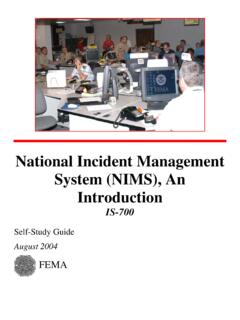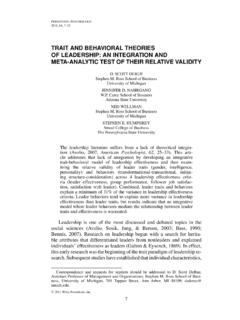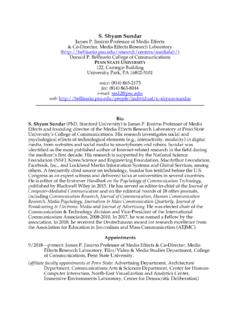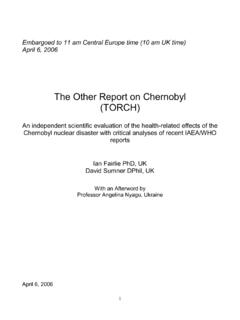Transcription of The Chernobyl Disaster (1986) - Pennsylvania State University
1 The Chernobyl Disaster (1986) Disaster MitigationThe Chernobyl Nuclear Reactor used a graphite reactor, called a positive void effect, thatproduced extremely unpredictable and uncontrollable spikes in power production. The positive voidreactor commonly produced large steam bubbles, referred to as voids in this system, within thereactor core which were identified as the cause of the large power surges. The team operating the plantidentified the reactor s design which produced these large steam bubbles as a hazard. The Chernobylreactor, however, remained operational until its explosion in 1986 due to the very steam bubblesidentified as a possible threat (along with the team decision to disable the automatic shutdown featuresof the plant) with no new precautions taken post identification of the design flaws.
2 It should be notedthat with the Chernobyl Disaster humanity learned that safety in the realm of nuclear power would haveto take the top priority in both the design and operation of nuclear power PreparednessWhile it there might not be many precautions individuals can take in case of a nuclear Disaster , an areacan develop emergency plans that would be executed if said Disaster were to occur. Planning alarge scale evacuation would obviously be crucial since radiation can spread extremely quickly andcause areas to be uninhabitable. Nowadays after learning from the incident, modern nuclear reactorsare fitted with teams who work closely with neighboring populations regularly to prepare for speedy andorderly evacuations.
3 Further reducing the likeliness of similar incident occurring, current reactors aredesigned with more efficient internal structures. One of the main issues of the Chernobyl reactors wasthat the power output could greatly increase if cooling water was lost or converted to steam, leading topower surges. Today, reactors are equipped with modified control rods that include neutron absorberswhich help create a more stable reactor. Along with internal design changes, automatic shut downmechanisms have also made advancements to operate much faster and more ResponseImmediately following the explosion of reactor four, firefighting crews attempted to put out thefire and limit the amount of radioactive material entering the environment.
4 The attempt to put out the firewith cooling water was abandoned within ten hours. Almost a day later Russian Military helicopterswere used to dump 2400 tonnes of lead and 1800 tonnes of sand onto the reactor which ultimately didnot stop the fire and radiation leakage, but also contributed to the overall difficulty in controlling thesituation in the days following. The sand and lead ironically increased the heat and thus amount ofradiation produced by the fire. It was not until ten days after the initial explosion that the fire was put outby nitrogen. As for the evacuation, the surrounding civilian population living in 76 different villages andthe city of Pripyat was not notified of the accident until 36 hours after the explosion.
5 They were giveniodine pills to combat radiation poisoning (given far too late to be effective) and were told they would beleaving the area within a days time without the knowledge they would not be able to return to theirhomes for many years. The people evacuated would become the world s first refugees due to a nuclearenergy related event. There was much confusion and lack of knowledge in the immediate handling of theChernobyl explosion which ultimately serves as a historical reference to authorities involved in futureplanning of nuclear emergency operations on how not to RecoveryThe United Nations has since developed the Chernobyl Recovery and Development Programme(CRDP), whose sole purpose is to fuel the recovery of the affected regions and eventually return themback to a State of normal living conditions.
6 The program focuses on the mitigation of the economic,environmental and social effects of the Chernobyl Disaster . By doing this, the program works withnumerous other organizations to help restore the affected regions back to normal conditions. In additionto the CRDP, the Chernobyl New Safe Confinement (NSC) is currently under construction and beingfunded by Chernobyl Shelter Fund. Its primary purpose is to contain the partially destroyed reactor andprevent further leakage of radioactive material. The structure should also allow for future deconstructionof the reactor. The NSC is expected to be completed by Tsunami and Earthquake (2004)MitigationWhen a country wants to prevent future disasters or emergencies they have gone through in thepast they have to prepare themselves to avoid these problems from occurring again.
7 The way they dothis is by making a hazard risk analysis. Once they have identified the hazards, they have to develop astrategy to avoid these hazards from becoming an emergency. These hazards are associated with theincorrect use of infrastructure and safety happened in Indonesia is that they were not prepared for a tsunami of that did not have tsunami alert systems and the population did not know a Disaster like that waspossible. The earthquake that triggered the tsunami was the strongest Indonesia had seen for 700 days, everything has changed in Indonesia. All of the infrastructure has been rebuilt withthe thought that a Disaster like this can happened again.
8 The buildings are constructed to withstand highimpact waves and earthquakes. There are tsunami emergency towers to which people can go to savetheir lives. There is also the Tsunami Warning System that is handled by the Pacific Tsunami WarningCenter, operated by the National Oceanic and Atmospheric Administration (NOAA). This organizationuses seismic data and a system of ocean buoys to monitor tsunami activity and issue bulletins. Their jobis also to watch and warn the population about impending tsunamis in the Pacific basin. Along theIndonesian coast, there are sirens that can alert the entire population within minutes that a tsunami iscoming. NOAA is also taking new precautions these days, as they are providing Disaster emergencyshelters in several locations close to the shore.
9 PreparednessThese are efforts made in advance to prevent emergencies by creating plans to help thepopulation get ready for such a natural Disaster . The major preparation for these disasters is training. Inthis way, the population where a hazard exists will know how to react in a Disaster like happened in Indonesia is that the population did not know how to react to a days everything has changed. At the shores, there are alarms. When these alarms sound, everysingle person has to evacuate or has to get into a safe zone. These people could go to high ground level,to the upper floors of buildings, or into the emergency towers. At hotels, the staff is prepared toevacuate every single guest.
10 People know how to react because the cities run tsunami drills several timesduring the year. There are evacuations roots that lead people to concentration points. In addition, all ofthe military and emergency services are prepared to act in the proper ResponseAfter a Disaster like this, it is the job of the IRD (International Relief and Development)organization to let the world know that there is a big Disaster and people are in need of help. During the2004 Indonesian Tsunami, the first thing that the IRD did was to send $ million dollars of rice and 40metric tons of ready to eat snacks, two containers of clothing, baby food, water, high protein biscuits,jerry cans for water purification.



















